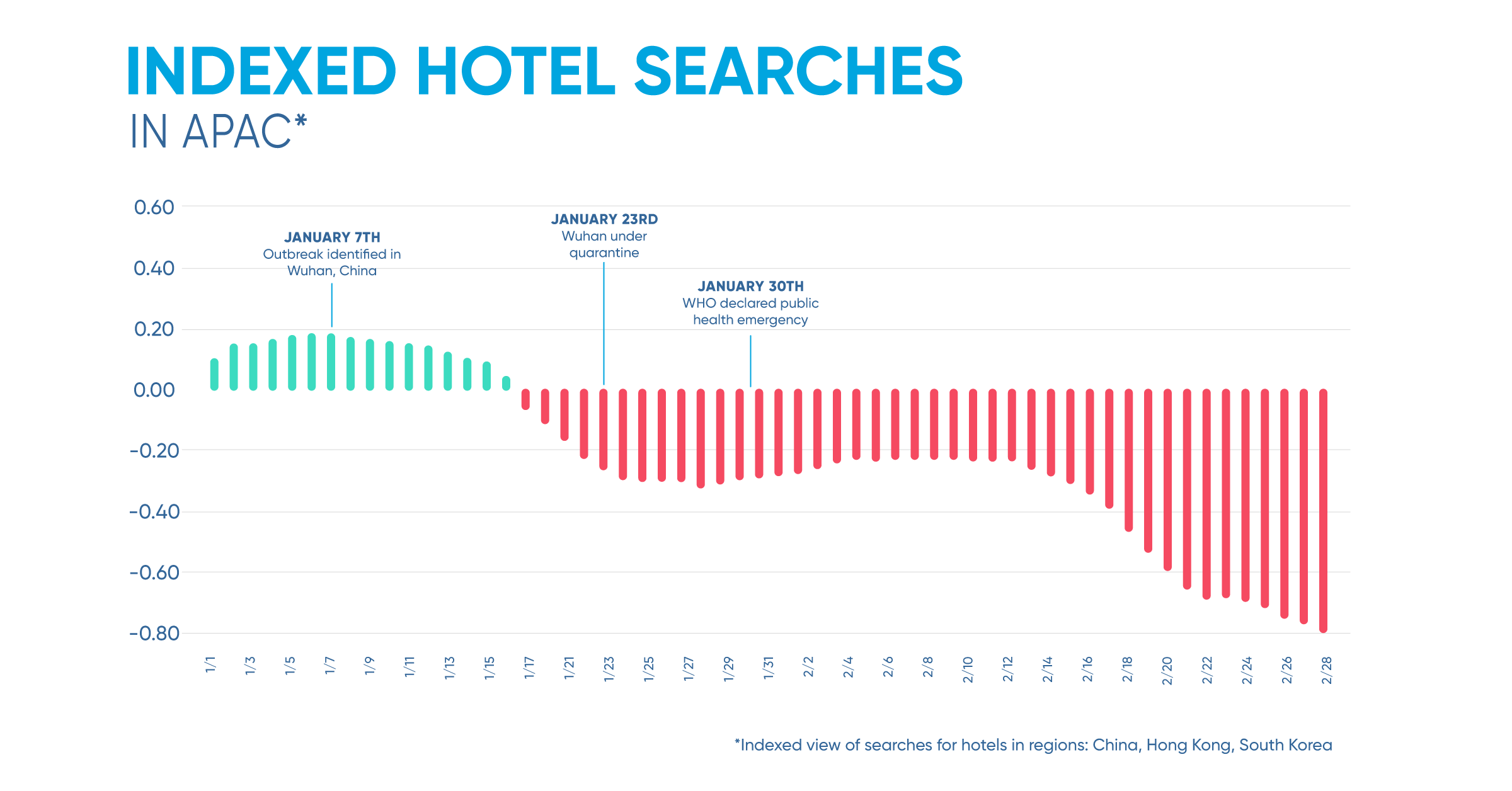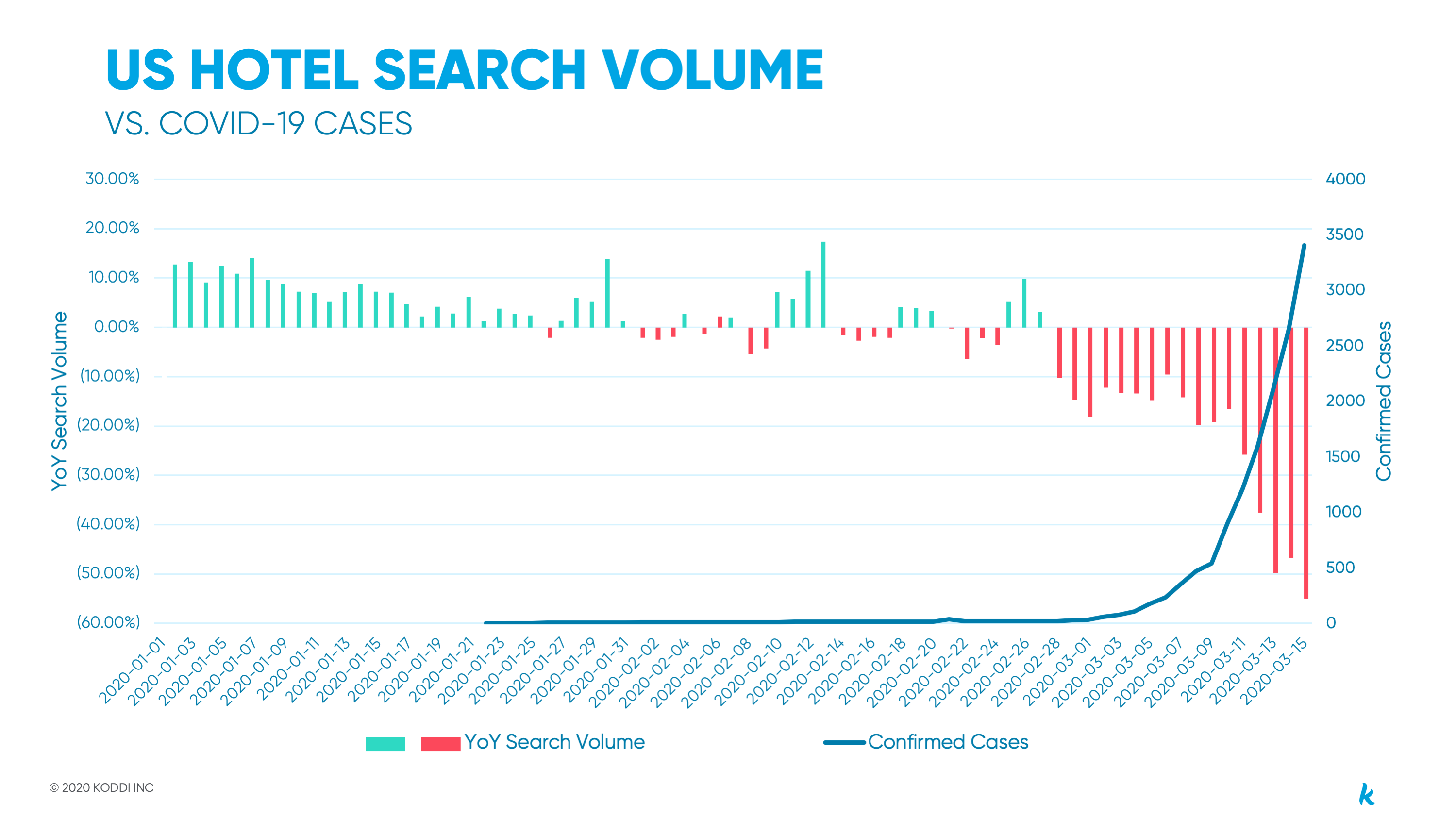
(UPDATED: MARCH 17, 2020) The growing international coronavirus health crisis is dramatically affecting consumer travel around the world, and global travel brands are feeling the impact most directly. As travel cancellations mount and travel to certain regions becomes more severely affected, travel brands should monitor the situation and smartly adjust their marketing spends to maximize their effectiveness during this unique event. In light of the outbreak, we’ve seen the cancellation of large events, including ITB Berlin and SXSW in Austin, as well as other major conferences, like Skift Europe and Phocuwright Europe, pushing to later in the year. Due to these cancellations and shifts, bookings and revenue are down in select destinations.
However, in most of the regions affected by coronavirus disease (COVID-19), we’re seeing disruption proportionate to the severity of the outbreaks. Here at Koddi, we’ve been monitoring the situation closely, as it affects our many travel partners. Based on what we’ve seen, here are our insights and recommendations as to how travel brands should be thinking about their spending patterns in light of the ever-evolving coronavirus situation.
In APAC
Across key APAC regions that are severely impacted by COVID-19, including China, Hong Kong, Korea, and Japan, we are seeing metasearch opportunities and traffic decline by 50-80 percent year-over-year, with low conversion rates and very high cancellation rates. Other APAC markets are also seeing declines between 30-50 percent.

At the end of February, some clients with a majority of their properties in the APAC region were reporting roughly 50-60 percent cancellation rates. Last week, that number jumped as high as 70-80 percent and continues to climb. China is still the most heavily affected country so far in the coronavirus outbreak, though there have been recent reports that new cases have started to drop.
In Europe
Over the past few weeks, Italy has seen roughly a 70 percent decline in search volume year-over-year, as the coronavirus has deeply affected the region. Meanwhile, with the outbreak becoming more widespread in European countries, other EU markets have seen demand drop by 50 percent year-over-year. Demand could drop further as the situation escalates in Europe. Travel brands should monitor Italy closely, as well as other destinations that report a large number of cases.
In North America
Initially, there was a smaller impact on domestic travel within North America. However, the end of last week brought a more drastic change with the announcement of additional travel restrictions to Europe as well as virtually all large gatherings (including major sporting events, conferences, concerts, and festivals) being canceled or postponed indefinitely. In looking at the impact across US travel search patterns, we can see a clear positive search traffic trend across the early portion of January, prior to any confirmed cases existing within the United States. We see a softening of that trend, however, as January closed and global cases began to escalate.
Starting on February 28th, when the World Health Organization raised its risk assessment of COVID-19 to “Very High,” US travel searches began to drop 10 percent year-over-year. As of last weekend, that trend has continued as US travel searches have dropped by 50 percent year-over-year. There have been more substantial impacts in states that have a high number of confirmed cases of COVID-19 including New York, California, and Washington. For a more in-depth analysis, see our coverage of the US travel market.
Keep Calm and Spend Wisely
Given the increasing cancellation rate for hotels, some of our clients have increased their ROI targets and are lowering budgets to make up for the cancellations. With the decreased demand and increased cancellation rates, we are seeing competition soften which is highlighted by the drop in CPCs in the market. Over the past few days, average CPCs have dropped over 40 percent across metasearch publishers. To maintain the top position, the drop off has been even greater with a 74 percent drop.
In the coming weeks and months, it will behoove travel brands to take a calculated approach to their campaign changes in light of the coronavirus, keeping long-term impact in mind. Brands shouldn’t cut spend or drastically reduce budgets as a knee-jerk reaction to the outbreak, but rather, they should take advantage of the areas and audiences where demand still exists. Instead of pausing all hotels, or all hotels for a certain point of sale, we recommend looking at specific destinations to see if they are affected (e.g., Italy, Disney Resorts) and then pausing campaigns or reducing spend in those areas on a case-by-case basis as needed.
Many publishers have advanced targeting criteria that can be used to select booking windows or audience segments that are still seeing demand. For example, the drop in traffic for hotels searches for same day and next day bookings has been lower compared to the other booking window segments. Our team is closely following the news and performance data, and we will continue to take needed actions and put forward proactive recommendations to our clients based on what we see in data.
Watch this page for new updates during the COVID-19 crisis or subscribe to our newsletter to be notified of future blog posts and insights.
You may be interested in
GET IN TOUCH
Ready to get started?
Don’t let your brand get lost in the noise. Partner with Koddi to unlock the power of commerce media and transform the way you engage with your customers. Our team of experts is here to help you navigate complexities and develop a strategy that drives results — no matter what industry – in as little as 45 days.

